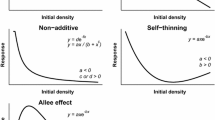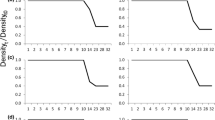Abstract
Density dependence is the major process keeping the sizes of natural populations within bounds. In organisms with complex life cycles, the stage at which density dependence occurs and whether it occurs in one or several life stages have important consequences for the dynamics of their populations. I manipulated density of pool frogs (Rana lessonae) during the aquatic larval and the terrestrial juvenile stages and examined the effect on growth and survival until 1 year of age. High larval density, but not high juvenile density, led to smaller size at this age. Both larval and juvenile density led to reduced growth during the early juvenile stage, but the effect of the larval density appeared stronger than the effect of juvenile density. No density dependence in survival could be found. My results suggest that density dependence in both the larval and the terrestrial juvenile stage may play important roles in the regulation and dynamics of amphibian populations.

Similar content being viewed by others
References
Altwegg R (2002) Trait-mediated indirect effects and complex life cycles in two European frogs. Evol Ecol Res 4:519–536
Altwegg R, Reyer H-U (2003) Patterns of natural selection on size at metamorphosis in water frogs. Evolution (in press)
Andrewartha HG, Birch LC (1954) The distribution and abundance of animals. University of Chicago Press, Chicago
Berryman AA (1991) Stabilization or regulation: what it all means! Oecologia 86:140–143
Berven KA (1990) Factors affecting population fluctuations in larval and adult stages of the wood frog (Rana sylvatica). Ecology 71:1599–1608
Berven KA (1995) Population regulation in the wood frog, Rana sylvatica, from three diverse geographic localities. Aust J Ecol 20:385–392
Biek R, Funk WC, Maxell BA, Mills LS (2002) What is missing in amphibian decline research: insights from ecological sensitivity analysis. Conserv Biol 16:728–734
Brockelman WY (1969) An analysis of density effects and predation in Bufo americanus tadpoles. Ecology 50:632–644
Golay N (1996) Die Kreuzkroete (Bufo calamita) Laur. als Pionierart. Dissertation, University of Basel, Switzerland
Gosner N (1960) A simplified table for staging anuran embryos and larvae with notes on identification. Herpetologica 16:183–190
Günther R (1990) Die Wasserfrösche Europas (Anura—Froschlurche). Die Neue Brehm-Bücherei, 600. Wittenberg Lutherstadt, Germany
Hanski I (1990) Density dependence, regulation and variability in animal populations. Philos Trans R Soc Lond B 330:141–150
Hellriegel B (2000) Single- or multistage regulation in complex life cycles: does it make a difference? Oikos 88:239–249
Holenweg A-K, Reyer H-U (2000) Hibernation behavior of Rana lessonae and R. esculenta in their natural habitat. Oecologia 123:41–47
Houlahan JE, Findlay CS, Schmidt BR, Meyer AH, Kuzmin SL (2000) Quantitative evidence for global amphibian population declines. Nature 404:752–755
Lebreton JD, Burnham KP, Clobert J, Anderson DR (1992) Modeling survival and testing biological hypotheses using marked animals: a unified approach with case studies. Ecol Monogr 62:67–118
McPeek M, Peckarsky BL (1998) Life histories and the strengths of species interactions: combining mortality, growth, and fecundity effects. Ecology 79:867–879
Morey S, Reznick D (2001) Effects of larval density on postmetamorphic spadefoot toads (Spea hammondii). Ecology 82:510–522
Nicholson AJ (1933) The balance of animal populations. J Anim Ecol 2:132–178
Pechmann JHK (1994) Population regulation in complex life cycles: aquatic and terrestrial density-dependence in pond-breeding amphibians. Dissertation, Duke University, N.C.
Pechmann JHK (1995) Use of large field enclosures to study the terrestrial ecology of pond-breeding amphibians. Herpetologica 51:434–450
Petranka JW (1989) Density-dependent growth and survival of larval Ambystoma: evidence from whole-pond manipulations. Ecology 70:1752–1767
Prout T, McChesney F (1985) Competition among immatures affects their adult fertility: population dynamics. Am Nat 126:521–558
Rodriguez DJ (1988) Models with density regulation in more than one life stage. Theor Popul Biol 34:93–117
Rodriguez DJ (1989) A model of population dynamics for the fruit fly Drosophila melanogaster with density dependence in more than one life stage and delayed density effects. J Anim Ecol 58:349–365
Royama T (1977) Population persistence and density dependence. Ecol Monogr 47:1–35
SAS Institute Inc. (1996) SAS / STAT Software: changes and enhancements through release 6.11. SAS Institute Inc., Cary, N.C.
Scott DE (1994) The effect of larval density on adult demographic traits in Ambystoma opacum. Ecology 75:1383–1396
Semlitsch RD (1993) Effects of different predators on the survival and development of tadpoles from the hybridogenetic Rana esculenta complex. Oikos 67:40–46
Semlitsch RD, Caldwell JP (1982) Effects of density on growth, metamorphosis, and survivorship in tadpoles of Scaphiopus holbrooki. Ecology 63:905–911
Smith DC (1983) Factors controlling tadpole populations of the chorus frog (Pseudacris triseriata) on Isle Royale, Michigan. Ecology 64:501–510
Som C, Anholt BR, Reyer H-U (2000) The effect of assortative mating on the coexistence of a hybridogenetic waterfrog and its sexual host. Am Nat 156:34–46
Stiling P (1988) Density-dependent processes and key factors in insect populations. J Anim Ecol 57:581–593
Stubbs M (1977) Density dependence in the life cycles of animals and its importance in K- and r- strategies. J Anim Ecol 46:677–688
Taylor BE, Scott DE (1997) Effects of larval density dependence on population dynamics of Ambystoma opacum. Herpetologica 53:132–145
Turchin P (1999) Population regulation: a synthetic view. Oikos 84:153–159
Van Buskirk J, Yurewicz KL (1998) Effects of predators on prey growth rate: relative contributions of thinning and reduced activity. Oikos 82:20–28
Vonesh JR, De la Cruz O (2002) Complex life cycles and density dependence: assessing the contribution of egg mortality to amphibian declines. Oecologia 133:325–333
White GC, Burnham KP (1999) Program MARK: Survival estimation from populations of marked animals. Bird Study 46:S120–139
Wilbur HM (1980) Complex life cycles. Annu Rev Ecol Syst 11:67–93
Wilbur HM (1996) Multistage life cycles. In: Rhodes OE, Chesser RK, Smith MH (eds) Population dynamics in ecological space and time. University of Chicago Press, Chicago, pp 75–108
Wolda H (1989) The equilibrium concept and density dependence tests. What does it all mean? Oecologia 81:430–432
Wolda H (1995) The demise of the population regulation controversy. Res Popul Ecol 37:91–93
Acknowledgements
Thanks to Sonja Angelone, Martina Arioli, Attila Hettyey, and Beni Schmidt for their help with the field work. Brad Anholt, Barbara Hellriegel, Uli Reyer, Beni Schmidt, Josh Van Buskirk, and three anonymous referees gave helpful comments on earlier versions of the manuscript. This work was supported by Swiss NF grant No. 31–40688.94 to H.-U. Reyer and No. 81ZH-68483 to R. A.
Author information
Authors and Affiliations
Corresponding author
Rights and permissions
About this article
Cite this article
Altwegg, R. Multistage density dependence in an amphibian. Oecologia 136, 46–50 (2003). https://doi.org/10.1007/s00442-003-1248-x
Received:
Accepted:
Published:
Issue Date:
DOI: https://doi.org/10.1007/s00442-003-1248-x




